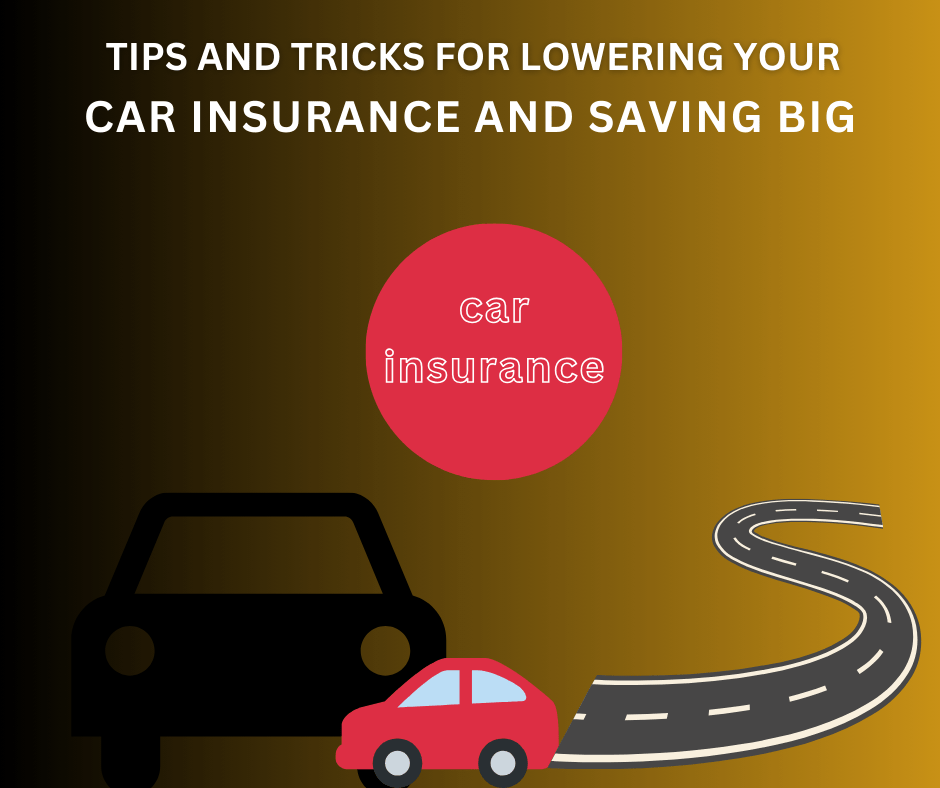Tips and Tricks For Lowering Your Car Insurance And Saving Big: In today’s world, car insurance is an essential expense for drivers, providing crucial financial protection in the event of accidents, theft, or damage.
However, the cost of premiums can often be a significant burden on a household budget. Fortunately, there are numerous strategies and tactics available to help drivers lower their car insurance costs and save substantial amounts of money.
By understanding these tips and tricks, individuals can effectively reduce their expenses while still maintaining the necessary coverage to protect themselves and their vehicles.
Which Type Of Car Insurance Is Best?
Finding the Right Fit: Unveiling the Best Car Insurance for Your Needs
Car insurance is a necessity, but with various coverage options, picking the “best” type can feel overwhelming. The truth is, there’s no one-size-fits-all answer. The ideal car insurance depends on your unique circumstances, car, and budget. Here’s a breakdown of common coverage options and who might benefit most from each:
Comprehensive Coverage:
- Protects against: Covers damage to your car from accidents (collision with another object or vehicle), theft, vandalism, weather events, fire, and animal collisions.
- Best for: New car owners, drivers with expensive vehicles, those living in areas prone to theft or vandalism, and people who want the most peace of mind.
Collision Coverage:
- Protects against: Covers repairs to your car if you collide with another object or vehicle (not as comprehensive as full coverage).
- Best for: Those financing or leasing a car (often required), drivers with newer cars with significant value, and people concerned about collision-related repair costs.
Liability Coverage:
- Protects against: Covers injuries and property damage you cause to others in an accident. This is mandatory in most countries.
- Best for: Everyone! This is the foundation of car insurance and protects you from financial ruin in case of an accident where you’re at fault.
Minimum Required Liability Coverage (varies by location):
- Protects against: Offers the least coverage, typically only meeting state minimums for bodily injury and property damage liability.
- Best for: Budget-conscious drivers with older, less valuable vehicles who are willing to take some financial risk. Remember, this offers minimal protection for your own car and assets.
Factors to Consider When Choosing Coverage:
- Value of your car: The more expensive your car, the more comprehensive coverage you might want.
- Your driving record: A clean record can qualify you for discounts and potentially lower coverage needs.
- Your risk tolerance: How comfortable are you absorbing repair costs in case of an accident?
- Local factors: Consider factors like theft rates and weather events in your area when choosing coverage.
Beyond the Basics: Optional Coverages
- Roadside Assistance: Provides help with flat tires, dead batteries, and towing. Can be valuable if you drive frequently or in remote areas.
- Rental Reimbursement: Covers the cost of a rental car if your vehicle is in the shop for repairs.
- Gap Insurance: Covers the difference between your car’s depreciated value and the amount owed on your loan if your car is totaled (often applies to newer cars).
Remember:
- Don’t be pressured into unnecessary add-ons. Evaluate your needs and budget before opting for optional coverages.
- Regularly review your coverage as your car’s value depreciates and your driving habits change.
The Takeaway:
The best car insurance is the one that provides adequate protection at a price you can afford. By understanding the different coverage options, considering your individual circumstances, and comparing quotes from multiple insurers, you can make an informed decision and choose the car insurance that best suits your needs.
Which Is a Type Of Insurance To Avoid?
Don’t Waste Your Money: Types of Insurance You Might Not Need
Insurance is a valuable tool for managing financial risk. It protects you from unexpected events that could cause significant expenses. However, not all insurance policies are created equal. Some might offer redundant coverage or cater to unlikely scenarios, leading to wasted money. Here’s a look at some types of insurance you might want to reconsider before signing on the dotted line:
1. Credit Card Payment Protection: This insurance covers your minimum credit card payments in case of job loss, disability, or illness. However, the premiums can be high, and the coverage often excludes pre-existing conditions or only lasts for a short period. Consider building an emergency fund to cover these situations instead.
2. Gap Insurance (for new cars): Gap insurance covers the difference between your car’s depreciated value and the amount owed on your loan if your car is totaled. While it offers peace of mind for new car purchases, the rapid depreciation of new vehicles means you might be upside down on the loan for a short time only. Running the numbers on depreciation rates and potential coverage costs can help you decide if it’s worthwhile.
3. Guaranteed Asset Protection (GAP) Insurance (for life insurance): This type of life insurance combines a death benefit with a savings component that supposedly grows at a guaranteed rate. However, the fees associated with GAP policies can be significant, and the returns may not be as competitive as other investment options. Consider term life insurance for pure death benefit coverage and invest your savings separately for potentially better returns.
4. Travel Insurance (for short, predictable trips): Travel insurance can be valuable for protecting your investment in case of trip cancellation, medical emergencies, or lost luggage. However, for short, domestic trips with minimal upfront costs (like pre-paid tours or cruises), the cost of travel insurance might outweigh the potential benefits.
5. Extended Warranties on Electronics: Most electronics come with a manufacturer’s warranty for a year or two. Extended warranties offered at the point of purchase can be expensive, and malfunctions beyond the standard warranty period are often due to normal wear and tear, not covered by these extensions.
Based on the information we discussed about avoiding unnecessary insurance, here are a couple of types of car insurance you might want to consider avoiding, depending on your circumstances:
-
Collision Coverage (for older cars): Collision coverage pays to repair or replace your car if you’re at fault in an accident or hit another object. However, if your car is older and its value has significantly depreciated, the cost of collision coverage might outweigh the value of the car itself. You can save money by dropping collision coverage for such vehicles, but remember you’ll be responsible for repairs or replacement if there’s an accident.
-
Rental Car Reimbursement: Rental car companies often try to sell you extra insurance coverage when you rent a car. However, in many cases, this coverage might be redundant. Check your existing car insurance policy and credit card benefits to see if they already offer rental car reimbursement. You might be surprised to find you’re already covered.
Remember:
- Review existing coverage: Before purchasing additional insurance, check your existing policies (homeowners, renters, auto) to see if they already offer some of the benefits you’re considering.
- Evaluate your risk tolerance: How likely are you to face the situations covered by the insurance? Consider your risk tolerance and financial situation before deciding if the coverage is necessary.
The Takeaway:
Insurance can be a valuable tool, but it’s important to be a savvy consumer. By understanding the limitations of certain policies and evaluating your individual needs, you can avoid paying for unnecessary coverage and make the most of your insurance budget.
What Is The Best Insurance For First Time Car Owners?
Finding the Right Fit: Unveiling the Best Car Insurance for Your Needs
Car insurance is a necessity, but with various coverage options, picking the “best” type can feel overwhelming. The truth is, there’s no one-size-fits-all answer. The ideal car insurance depends on your unique circumstances, car, and budget. Here’s a breakdown of common coverage options and who might benefit most from each:
Comprehensive Coverage:
- Protects against: Covers damage to your car from accidents (collision with another object or vehicle), theft, vandalism, weather events, fire, and animal collisions.
- Best for: New car owners, drivers with expensive vehicles, those living in areas prone to theft or vandalism, and people who want the most peace of mind.
Collision Coverage:
- Protects against: Covers repairs to your car if you collide with another object or vehicle (not as comprehensive as full coverage).
- Best for: Those financing or leasing a car (often required), drivers with newer cars with significant value, and people concerned about collision-related repair costs.
Liability Coverage:
- Protects against: Covers injuries and property damage you cause to others in an accident. This is mandatory in most countries.
- Best for: Everyone! This is the foundation of car insurance and protects you from financial ruin in case of an accident where you’re at fault.
Minimum Required Liability Coverage (varies by location):
- Protects against: Offers the least coverage, typically only meeting state minimums for bodily injury and property damage liability.
- Best for: Budget-conscious drivers with older, less valuable vehicles who are willing to take some financial risk. Remember, this offers minimal protection for your own car and assets.
Factors to Consider When Choosing Coverage:
- Value of your car: The more expensive your car, the more comprehensive coverage you might want.
- Your driving record: A clean record can qualify you for discounts and potentially lower coverage needs.
- Your risk tolerance: How comfortable are you absorbing repair costs in case of an accident?
- Local factors: Consider factors like theft rates and weather events in your area when choosing coverage.
Beyond the Basics: Optional Coverages
-
- Roadside Assistance: Provides help with flat tires, dead batteries, and towing. Can be valuable if you drive frequently or in remote areas.
- Rental Reimbursement: Covers the cost of a rental car if your vehicle is in the shop for repairs.
- Gap Insurance: Covers the difference between your car’s depreciated value and the amount owed on your loan if your car is totaled (often applies to newer cars).
Who Normally Has The Cheapest Car Insurance?
Who Scores the Lowest Rates? Unveiling the Cheapest Car Insurance Demographics in the UK, USA, and Canada
Car insurance premiums are not created equal. While factors like your driving record and car choice significantly impact costs, certain demographics tend to benefit from lower rates. Here’s a breakdown of who typically qualifies for cheaper car insurance in the UK, USA, and Canada:
The UK:
- Low-Mileage Drivers: Those who drive fewer miles annually are seen as posing less risk and qualify for lower premiums. Consider carpooling, using public transport, or opting for a limited mileage policy if applicable.
- Mature Drivers: Drivers over the age of 25, especially those with clean records, are statistically less likely to be involved in accidents and receive lower premiums.
- Multi-Policyholders: Bundling car insurance with home insurance or other policies can lead to significant discounts from UK insurers.
- Advanced Driving Course Participants: Taking defensive driving courses demonstrates a commitment to safe driving and can lead to lower premiums.
The USA:
- Good Drivers with Clean Records: A history free of accidents and traffic violations is the golden ticket to lower premiums in the USA.
- Military Members and Veterans: Many US insurers offer special discounts to active military personnel, veterans, and their families.
- Low-Mileage Drivers: Similar to the UK, those who drive less are seen as lower risk in the USA and qualify for lower rates.
- College Students with Good Grades: Some US insurers offer discounts to young drivers with good academic records, recognizing responsible behavior.
Canada:
- Low-Mileage Drivers: Just like in other countries, low annual mileage is a key factor for securing lower premiums in Canada.
- Experienced Drivers: Canadian insurers typically reward drivers with a clean record over the age of 25 with lower rates.
- Students with Good Grades: Similar to the USA, some Canadian insurers offer discounts to young drivers with strong academic performance.
- Group Discounts: Being a member of certain professional organizations or alumni groups might grant you access to special car insurance discounts in Canada.
Important to Remember:
- These are general trends, and individual rates will vary based on specific circumstances.
- Always compare quotes from multiple insurers to find the best deal.
- Maintaining a safe driving record is the most significant factor influencing your car insurance rates across all three countries.
By understanding these demographic trends and implementing safe driving habits, you can position yourself to score some of the cheapest car insurance rates available in the UK, USA, and Canada. Remember, comparison shopping and maintaining a clean record are key to keeping your car insurance costs under control.
How to Save Money on Car Insurance?
Drive Smart, Save Money: Top Tips to Reduce Your Car Insurance Costs in the USA
Car insurance is a mandatory expense for drivers in the USA, but that doesn’t mean you have to break the bank to stay covered. By adopting some smart strategies and understanding how insurers calculate rates, you can significantly reduce your car insurance premiums. Here’s a breakdown of key steps to take:
Shop Around and Compare Rates:
- Don’t settle for your current insurer’s renewal offer. Get quotes from at least three different insurance companies each time your policy is up for renewal. Online comparison tools and independent insurance agencies can streamline this process.
Maintain a Good Driving Record:
- Traffic violations and accidents significantly increase insurance premiums. Avoiding moving violations, maintaining a clean driving record, and completing defensive driving courses can demonstrate you’re a safe driver and qualify for discounts.
Increase Your Deductible:
- The deductible is the amount you pay out of pocket before your insurance kicks in. Opting for a higher deductible lowers your monthly premium. However, choose a deductible you can comfortably afford in case of an accident.
Drive Less (if possible):
- Insurers reward low-mileage drivers. Consider carpooling, using public transportation for errands, or opting for a fuel-efficient vehicle to qualify for lower mileage-based premiums offered by some insurers.
Bundle Your Insurance:
- Many insurers offer discounts when you bundle your car insurance with other policies, such as homeowners or renters insurance. Explore bundling options to leverage potential savings.
Review Your Coverage Regularly:
- Your insurance needs change over time. Regularly assess your coverage. As your car depreciates, you might not need the same level of comprehensive or collision coverage. Removing unnecessary coverage can save you money.
Consider Usage-Based Insurance:
- Telematics programs offered by some insurers track your driving habits (mileage, time of day, braking patterns) and provide discounts for safe driving. This option can be beneficial if you’re a low-mileage driver or particularly cautious behind the wheel.
Maintain a Good Credit Score:
- In most states, your credit score is a factor in determining your car insurance rates. Maintaining a good credit history can lead to lower premiums.
Don’t Skimp on Essential Coverage:
- While saving money is important, prioritize essential coverage. Liability insurance protects you from financial responsibility if you injure someone or damage their property in an accident. Ensure you have adequate liability coverage to protect yourself from significant financial burdens.
Be Wary of Additional Coverages:
- While add-on coverages can provide benefits in specific situations, carefully evaluate their necessity. Rental car reimbursement or roadside assistance might be redundant if already offered by your credit card or roadside assistance memberships.
Stay Informed:
- Insurance regulations and discounts can change. Stay updated on potential savings opportunities and adjust your coverage accordingly.
By following these tips and being a smart consumer, you can navigate the world of car insurance in the USA with confidence and keep your car insurance costs under control. Remember, the key is to compare rates, maintain a safe driving record, and tailor your coverage to your specific needs and budget.
Hit the Brakes on High Rates: Saving Strategies for Canadian Car Insurance
Car insurance is a necessary expense for Canadian drivers, but navigating the world of premiums and coverage options can be daunting. The good news is there are strategic steps you can take to keep your car insurance costs in check. Here’s a Canadian-focused guide to saving money on your car insurance:
Embrace Comparison Shopping:
- Don’t simply renew with your current insurer year after year. Get quotes from several Canadian insurance providers, including national brands and regional companies. Utilize online comparison tools or contact independent insurance brokers to get a comprehensive picture of rates.
Maintain a Spotless Driving Record:
- In Canada, as elsewhere, a clean driving record is king. Avoid traffic violations and accidents. Completing defensive driving courses demonstrates safe driving habits and can lead to significant premium discounts.
Choose a Higher Deductible:
- The deductible is the amount you pay out of pocket before your insurance kicks in. Opting for a higher deductible lowers your monthly premium. However, remember to choose a deductible you can comfortably afford in case of an accident.
Become a Low-Mileage Driver (if possible):
- Canadian insurers often reward policyholders who drive less. Consider carpooling, using public transit for errands, or choosing a fuel-efficient vehicle. Some insurers offer lower premiums based on mileage-tracking programs.
Bundle Up and Save:
- Many Canadian insurance companies provide discounts when you bundle your car insurance with other policies, like home or tenant insurance. Explore bundling options to maximize your savings potential.
Review and Revise Regularly:
- Your car and driving habits change over time. Regularly assess your coverage needs. As your car depreciates, you might not need the same level of comprehensive or collision coverage. Removing unnecessary coverage can free up savings.
Pay Attention to Usage-Based Insurance:
- Telematics programs offered by some Canadian insurers track your driving habits (distance driven, time of day, braking patterns) and provide discounts for safe driving. If you’re a low-mileage driver or particularly cautious behind the wheel, you could benefit from this option.
Maintain a Good Credit History:
- In Canada, your credit score can be a factor in determining your car insurance rates. Maintaining a good credit history can lead to lower premiums.
Prioritize Essential Coverage:
- While saving money is important, don’t skimp on essential coverage. Liability insurance protects you from financial responsibility if you injure someone or damage their property in an accident. Ensure you have adequate liability coverage to protect yourself from significant costs.
Be Wary of Optional Coverages:
- While add-on coverages can provide benefits, carefully evaluate their necessity. Rental car reimbursement or roadside assistance might be redundant if already offered by your credit card or roadside assistance memberships.
Stay Updated on the Canadian Insurance Landscape:
- Insurance regulations and discounts can change in Canada. Stay informed about potential savings opportunities and adjust your coverage accordingly.
By following these tips and being a proactive consumer, you can keep your Canadian car insurance costs affordable. Remember, comparison shopping, maintaining a safe driving record, and tailoring your coverage to your specific needs are key strategies for saving money on your car insurance in Canada.
Outsmart the Insurance Maze: Top Tips to Reduce Car Insurance Costs in the UK
Car insurance is mandatory for all drivers in the UK, but keeping your premiums in check can feel like navigating a complex maze. By understanding how UK insurers calculate rates and implementing some smart strategies, you can significantly reduce your car insurance costs. Here’s a breakdown of key steps to take:
Shop Around and Compare Quotes (Annually):
- Don’t just accept your current insurer’s renewal offer. It’s crucial to compare quotes every year from a variety of UK insurance providers, including national brands and specialist brokers. Online comparison tools can streamline this process, allowing you to get multiple quotes quickly.
Maintain a Squeaky Clean Driving Record:
- In the UK, as elsewhere, a clean driving license is gold. Avoid penalty points and accidents. Taking defensive driving courses demonstrates you’re a safe driver and can qualify you for discounts on your premiums.
Increase Your Voluntary Excess (Deductible):
- The voluntary excess, also known as the deductible, is the amount you pay out of pocket before your insurance kicks in. Opting for a higher voluntary excess lowers your monthly premium. However, choose a voluntary excess you can comfortably afford in case of an accident.
Reduce Your Mileage (if possible):
- Many UK insurers reward low-mileage drivers. Consider carpooling, using public transportation for errands, or choosing a fuel-efficient vehicle. Some insurers offer “black box” telematics programs that track your mileage and offer discounts for lower mileage drivers.
Explore Multi-Car and Multi-Policy Discounts:
- UK insurers often provide discounts for insuring multiple vehicles on the same policy or bundling car insurance with other policies, like home or travel insurance. Explore bundling options to leverage potential savings.
Review Your Cover Levels Regularly:
- Your car’s value and your driving habits change over time. Regularly assess your coverage needs. As your car depreciates, you might not need the same level of comprehensive cover. Removing unnecessary coverage can save you money.
Consider Limited Mileage Policies (if applicable):
- If you drive very few miles each year, a limited mileage policy from a UK insurer could be a good option. These policies restrict the annual mileage you can drive and offer lower premiums in exchange.
Maintain a Good Credit Score:
- In the UK, your credit score can be a factor in determining your car insurance rates. Maintaining a good credit history can lead to lower premiums.
Don’t Be Tempted by Unnecessary Add-Ons:
- While add-on covers like breakdown insurance or windscreen cover can be beneficial, carefully evaluate their necessity. You might already have breakdown cover through your car manufacturer’s warranty or roadside assistance offered by your bank account.
Stay Informed About UK Insurance Updates:
- Insurance regulations and discounts can change in the UK. Stay updated on potential savings opportunities and adjust your coverage accordingly.
By following these tips and being a savvy consumer, you can navigate the world of UK car insurance with confidence and keep your premiums under control. Remember, the key is to compare quotes regularly, maintain a safe driving record, and tailor your coverage to your specific needs and budget.
Conclusion
In conclusion, there are various effective methods for lowering your car insurance premiums and saving big on your overall expenses.
By carefully evaluating your coverage needs, comparing quotes from different insurers, and taking advantage of available discounts, you can significantly reduce your insurance costs without compromising on quality protection.
Additionally, maintaining a clean driving record, improving your credit score, and considering bundling policies can further enhance your savings potential. With these tips and tricks at your disposal, you can navigate the world of car insurance with confidence, ensuring both financial security and peace of mind every time you hit the road.






